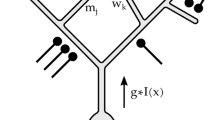Abstract
Functional differences between the type I and II receptive fields of the lateral geniculate body were studied in the cat. Some properties of these fields were shown to coincide with properties of "phasic" (Y type) and "tonic" (X type) of receptive fields. The type I fields have a limited range for transmission of information about the intensity of illumination; the type II fields, on the other hand, have a normal dynamic range of 2 log units. Using the number of spikes in groups as a measure of nervous activity, a neurophysiological scale of brightness corresponding to the psychological scale can be constructed on the basis of responses of the type II receptive field. It is postulated that type I receptive fields serve to transmit information on the shape of the image (spatial and temporal contrasts) and the type II fields transmit information on intensity of illumination. Investigation of the dynamic functional model showed that the type of receptive field is determined by the depth of inhibition through the interneuron. The depth of inhibition is much greater for type I than for type II.
Similar content being viewed by others
Literature cited
V. A. Besekerskii and E. P. Popov, Theory of Automatic Control Systems [in Russian], Nauka, Leningrad (1966).
V. D. Glezer, K. N. Dudkin, V. A. Ivanov, and A. P. Kul'kov, "The encoding signals by neurons of the visual system," in: Investigation of the Principles of Information Analysis in the Visual System [in Russian], Nauka, Leningrad (1970), pp. 86–105.
V. D. Glezer, V. A. Ivanov, and T. A. Shcherbach, "Receptive fields of the cat lateral geniculate body," Neirofiziologiya,3, 131 (1971).
V. D. Glezer and A. M. Kuperman, "A model of the dependence of visual acuity on contrast," Biofizika,17, 110 (1972).
K. N. Dudkin, "Encoding of photic stimuli by neurons of the visual cortex in the light of the theory of statistical solutions," in: Analysis of Visual Information and Regulation of Motor Activity [in Russian], Sofia (1971), pp. 79–83.
K. N. Dudkin and V. E. Gauzel'man, "A model of stimulus analysis in neuronal groups such as the glomerulus of the lateral geniculate body of the visual system," Biofizika,18, 715 (1973).
A. M. Kuperman and V. D. Glezer, "A model of the dependence of visual acuity on intensity of illumination and the optical properties of the eye," Biofizika,19, 157 (1974).
M. L. Stockham, "Image analysis in the contex of a model of vision," in: Image Analysis with the Aid of Computers [Russian translation], Moscow (1973), pp. 122–137.
B. G. Cleland, M. W. Dubin, and W. R. Levick, "Sustained and transient neurones in the cat's retina and lateral geniculate nucleus," J. Physiol. (London),217, 473 (1971).
V. D. Glezer, N. F. Podvigin, A. M. Kuperman, V. A. Ivanov, and T. A. Tsherbach, "Investigations of receptive fields of cat's corpus geniculatum lateralis. Structural and functional model of the field," Vision Res.,12, 2071 (1972).
C. Enroth-Cugell and S. G. Robson, "The contrast sensitivity of retinal ganglion cells of the cat," J. Physiol. (London),187, 517 (1966).
C. Enroth-Cugell and R. M. Shapley, "Flux, not retinal illumination, is what cat retinal ganglion cells really care about," J. Physiol. (London),233, 311 (1973).
T. L. Hickey, R. W. Winters, and J. G. Pollack, "Center-surround interactions in two types of on-center retinal ganglion cells in the cat," Vision Res.,13, 1511 (1973).
K. P. Hoffman, J. Stone, and S. M. Sherman, "Relay of receptive-field properties in dorsal lateral geniculate nucleus of the cat," J. Neurophysiol.,35, 518 (1972).
R. E. Kalil and R. Chase, "Corticofugal influence on activity of lateral geniculate neurons in the cat." J. Neurophysiol.,30, 459 (1970).
E. G. Jones and T. P. S. Powell, "An electron microscopic study of the mode of termination of corticothalamic fibers within the sensory relay nuclei of the thalamus," Proc. Roy. Soc., Ser. B.(1969), p. 172.
H. Saito, T. Shimahara, and Y. Fukada, "Four types of responses to light and dark spot stimuli in the cat optic nerve," Tohoku J. Exptl. Med.,102, 127 (1970).
S. S. Stevens, "Problems and methods of psychophysics," Psychol. Bull.,54, 177 (1958).
Additional information
I. P. Pavlov Institute of Physiology, Academy of Sciences of the USSR, Leningrad. Translated from Neirofiziologiya, Vol. 7, No. 1, pp. 27–34, January–February, 1975.
Rights and permissions
About this article
Cite this article
Dudkin, K.N., Glezer, V.D. & Gauzel'man, V.E. Types of receptive fields of the lateral geniculate body and their functional model. Neurophysiology 7, 21–26 (1975). https://doi.org/10.1007/BF01063020
Received:
Issue Date:
DOI: https://doi.org/10.1007/BF01063020




